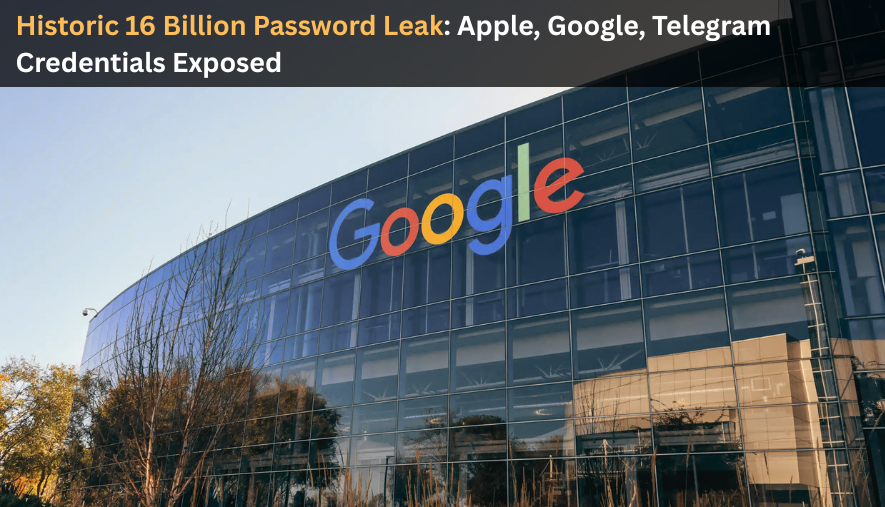
Unprecedented Scale of the Password Leak
In a shocking revelation, cybersecurity researchers have uncovered what is being described as the largest data breach in internet history, with over 16 billion login credentials exposed across multiple platforms. This colossal breach includes sensitive data from major services such as Apple, Google, Telegram, Facebook, GitHub, and even government portals. The data breach has sent ripples through the cybersecurity community, highlighting the urgent need for enhanced online security measures.
How the Data Breach Occurred
The data breach originated from a series of sophisticated cyberattacks involving infostealer malware. These malicious programs are designed to infiltrate devices—such as smartphones, tablets, and computers—and silently extract sensitive information, including usernames, passwords, and other login credentials. Unlike traditional data breaches that often target a single organization, this incident involves a collection of 30 distinct datasets, each containing millions to billions of records. These datasets were compiled by cybercriminals and possibly some independent researchers, with the data being stored in unsecured or misconfigured databases, such as Elasticsearch instances or object storage systems. This massive data breach underscores the growing threat of infostealer malware, which operates covertly to harvest credentials without users’ knowledge.
The Role of Infostealer Malware in the Breach
Infostealer malware is a type of malicious software that quietly collects sensitive information from infected devices. In this data breach, the malware targeted a wide range of platforms, extracting login details for services like Apple IDs, Google accounts, Telegram chats, and more. The stolen data was then aggregated into massive datasets, some containing over 3.5 billion records.Significantly, a dataset containing 455 million records was tied to Russian-speaking users, while another with 60 million records was connected to Telegram. The structured nature of the leaked data—organized with URLs, usernames, and plain-text passwords—makes it a potent tool for cybercriminals, enabling targeted phishing, account takeovers, and identity theft.
Impact of the 16 Billion Credential Leak
The scale of this data breach is staggering, with an estimated 16 billion login credentials exposed, potentially affecting billions of internet users worldwide.With more than 5.5 billion internet users worldwide, a substantial number of online accounts are likely compromised.The data breach affects a diverse range of platforms, including social media networks like Facebook and Instagram, as well as critical systems such as government portals and VPN services.This extensive leak provides a “roadmap for widespread exploitation,” according to researchers, creating significant threats for both individuals and organizations.
Why This Breach Is a Cybersecurity Nightmare
The data breach is particularly alarming due to its recency and structure. Unlike older leaks that recycle outdated credentials, these datasets contain fresh, actionable intelligence. The plain-text format of the passwords makes them immediately usable by hackers, who can exploit them for:
- Phishing Attacks: Using stolen credentials to craft convincing, personalized scams.
- Account Takeovers: Gaining unauthorized access to user accounts to steal personal or financial information.
- Identity Theft: Leveraging compromised data to impersonate users and commit fraud.
- Business Email Compromise (BEC): Targeting corporate systems to infiltrate organizations.
The data breach also includes sensitive metadata, such as tokens and cookies, which can bypass weak security measures, especially on platforms lacking robust multi-factor authentication (MFA).
See full Youtube Video- Massive Data Breach Exposes 16 Billion Passwords
Steps to Protect Yourself After the Data Breach
Given the unprecedented scale of this data breach, immediate action is essential to safeguard your online accounts. Here are critical steps to mitigate risks:
- Change Your Passwords: Update passwords for all major accounts, prioritizing services like Apple, Google, Telegram, and Facebook. Create robust, distinct passwords using a mix of letters, numbers, and symbols.
- Enable Multi-Factor Authentication (MFA): Activate MFA on all accounts that support it, preferably using authenticator apps or hardware keys, as SMS-based MFA can be vulnerable to phishing.
- Use a Password Manager: Store complex passwords securely with a reputable password manager to avoid reusing credentials across platforms.
- Scan for Malware: Run deep scans on all devices using trusted antivirus or anti-malware software to detect and remove infostealer malware.
- Monitor the Dark Web: Use services like Google One’s Dark Web Report or Have I Been Pwned to check if your credentials have been exposed.
- Be Vigilant for Phishing: Watch for suspicious emails or messages that may exploit stolen credentials to trick you into revealing more information.
Additional Precautions for Organizations
Businesses must also act swiftly to address the fallout from this data breach. Recommendations include:
- Implementing mandatory MFA for all employees, especially for admin or VPN access.
- Regularly auditing login activity to detect unusual patterns or unauthorized access.
- Educating staff about phishing risks and the dangers of reusing passwords.
- Investing in advanced cybersecurity tools, such as Splunk, to monitor for compromised credentials.
The Broader Implications of the Data Breach
This data breach serves as a stark reminder of the evolving nature of cyber threats. The ease with which infostealer malware can harvest credentials highlights the need for stronger cybersecurity practices at both individual and corporate levels. Experts emphasize that the accessibility of stolen data on the dark web—sometimes available for purchase with minimal technical knowledge—amplifies the risk of widespread exploitation. The data breach also raises concerns about national security, with reports of 220 .gov email addresses found in a sample of the leaked records, signaling potential vulnerabilities in government systems.
A Call for Stronger Cybersecurity Measures
The data breach underscores the importance of proactive cybersecurity. As cybercriminals shift from decentralized platforms like Telegram groups to centralized databases for distributing stolen data, the threat landscape is becoming more dangerous. Users and organizations must prioritize robust security practices, such as adopting FIDO2-based authentication, which is resistant to phishing, and regularly updating software to patch vulnerabilities.
What People Can Do Is Act Now to Secure Your Digital Life
The exposure of 16 billion login credentials in this historic data breach is a wake-up call for internet users worldwide. By taking immediate steps to update passwords, enable MFA, and monitor for suspicious activity, you can reduce the risk of falling victim to this unprecedented leak. As the cybersecurity landscape continues to evolve, staying vigilant and informed is critical to protecting your digital identity.








